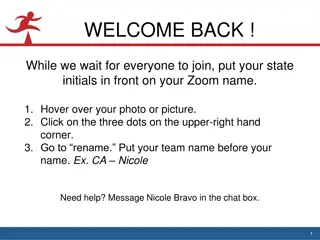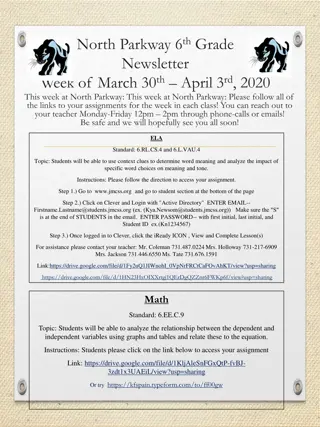
European Imperial Expansion and Exhibition of Non-European Cultures
Explore how European imperial expansion in the 19th century led to the commodification and display of non-European peoples and cultures through artifacts, human remains, and live exhibitions. The narrative delves into the construction of racialized otherness by Europeans, presenting non-Europeans as curiosities for metropolitan audiences. Learn about early African entertainments abroad, from the Hottentot Venus to Africa's first Olympians, and the intersecting realms of ethnographic science and entertainment that characterized these exhibitions.
Download Presentation

Please find below an Image/Link to download the presentation.
The content on the website is provided AS IS for your information and personal use only. It may not be sold, licensed, or shared on other websites without obtaining consent from the author. If you encounter any issues during the download, it is possible that the publisher has removed the file from their server.
You are allowed to download the files provided on this website for personal or commercial use, subject to the condition that they are used lawfully. All files are the property of their respective owners.
The content on the website is provided AS IS for your information and personal use only. It may not be sold, licensed, or shared on other websites without obtaining consent from the author.
E N D
Presentation Transcript
D I F F E R E N C E O N D I S P L AY Week 8 Mayukha Rodrigo & Nyssa Addae
TO P I C OV E RV I E W TO P I C OV E RV I E W This week s topic explores how European imperial expansion in the 19th century led to the commodification and display of non-European peoples and cultures. Through artefacts, human remains, and live exhibitions, Europeans constructed a framework of racialised otherness, presenting non-Europeans as curiosities to be studied and entertained by metropolitan audiences.
E A R L Y A F R I C A N E N T E R T A I N M E N T S A B R O A D : F R O M T H E E A R L Y A F R I C A N E N T E R T A I N M E N T S A B R O A D : F R O M T H E H O T T E N T O T V E N U S T O A F R I C A ' S F I R S T O L Y M P I A N S H O T T E N T O T V E N U S T O A F R I C A ' S F I R S T O L Y M P I A N S B Y B E R N T H L I N D F O R S , C H A P T E R 7 ' D R K A H N A N D T H E N I A M B Y B E R N T H L I N D F O R S , C H A P T E R 7 ' D R K A H N A N D T H E N I A M - - N I A M S N I A M S ' , P P . 1 2 3 ' , P P . 1 2 3 - - 1 3 0 1 3 0 Dr Kahn's Anatomical Museum aimed to merge ethnographic science and entertainment near London's Piccadilly Circus - contained natural and artificial preparations illustrating such physiological phenomena, many in the form of wax models Introduction of the Niam-Niams, who were advertised as "Tailed Family" from Central Africa, which highlighted European fascination with "tailed humans", a recurring myth in anthropological history The description of the Niam-Niams seemed animalistic, due to the large emphasis on features like "long arms", "high cheekbones" and "tail" as symbols of primitivism - depicted as savage cannibals, reinforcing racial stereotypes prevalent in 19th-century Europe. British scientific community were largely skeptical, dismissing the exhibition as sensational and lacking evidence. - "probably no more than a tall tale in wax." The public, however, eagerly consumed these narratives, reflecting deep racial biases "in the public mind the humanity of Africans was still in question" Quote Quote - - "Yet what, after all, is there remarkable in men with tails? What law of nature does it violate? "Yet what, after all, is there remarkable in men with tails? What law of nature does it violate? What axiom in natural science is it in opposition to? What established principles of anatomy does it over What axiom in natural science is it in opposition to? What established principles of anatomy does it over throw?" throw?"
L I V I N G E T H N O L O G I C A L E X H I B I T S : T H E C A S E O F L I V I N G E T H N O L O G I C A L E X H I B I T S : T H E C A S E O F 1 8 8 6 1 8 8 6 I N I N C U L T U R A L A N T H R O P O L O G Y C U L T U R A L A N T H R O P O L O G Y A R T I C L E A R T I C L E B Y S A L O N I M A T H U R , B Y S A L O N I M A T H U R , 2 0 0 0 2 0 0 0 Ethnological exhibits like the 1886 Colonial and Indian Exhibition reflected European fascination with the "exotic" and provided staged spectacles of imperial domination. - Living ethnological displays created a powerful stock of images of the non-Western world for European consumption" These exhibitions emphasised racial hierarchies by depicting non-European cultures as static, premodern, and inferior, reinforcing Victorian notions of progress - "the Indian craftsman, who embodied the timelessness of the Indian village" The portrayal of colonies as sources of raw materials and cultural artefacts served to justify imperial exploitation, with the exhibits often celebrating the "benevolence" of colonial rule. - "strengthen the bonds of union now existing in every portion of her Majesty s Empire" While performers like Tulsi Ram occasionally resisted their objectification, their ability to shape their image was constrained by exploitative recruitment practices and colonial hierarchies. Tulsi Ram stated "I want justice until I get that I will die sooner than return Displays of imperial subjects also reflected underlying fears about the stability of empire, particularly the visibility of colonial subjects in metropolitan spaces like London. Quote Quote - - "The awkward presence of subaltern colonial figures among London s urban poor was seen as an "The awkward presence of subaltern colonial figures among London s urban poor was seen as an embarrassing imposition on urban life embarrassing imposition on urban life
C H . 5 : C O L O N I A L I S M A N D W E S T E R N P O P U L A R C H . 5 : C O L O N I A L I S M A N D W E S T E R N P O P U L A R C U L T U R E , C U L T U R E , I N I N W H I T E O N B L A C K : I M A G E S O F A F R I C A A N D W H I T E O N B L A C K : I M A G E S O F A F R I C A A N D B L A C K S I N W E S T E R N P O P U L A R B L A C K S I N W E S T E R N P O P U L A R C U L T U R E N E D E RV E E N N E D E RV E E N P I E T E R S E P I E T E R S E , 1 9 9 2 , 1 9 9 2 C U L T U R E , J A N , J A N The basic colonial image of the native, is as far as Africa is concerned an enemy image, with African societies called 'stateless' and existing in a state of natural anarchy Illustrated London News 1873, made series of articles about Ashanti, under the headline of 'The Gold Coast and Ashantee War' - sinister witch doctors depicted in word and image, along with dark 'Juju' - these images reflected rural and pastoral image of Africa Fetishism was one of the classic ingredients of the enemy image of Africans. Fetishism took the form of a reversion to belief in England s God, a barbarian tribal deity who fights with and for our battalions French mocked Germany, who used many non-black soldiers. Ethnologist Leo Frobenius mocked non-European soldiers deployed by German enemies - prints a series of photographs carrying denigrating captions such as: 'coloured Frenchmen in the field during combat' New mythology took place which converted slaves into political subjects as they were deemed as impressionable as children and images such as that of Ludwig hohowein reinforced this During heyday of imperialism, many exhibits of peoples were organised: at a price, the public were shown Indians natives and negroes - people on display were trophies of victory Quote: "figures of the world s non figures of the world s non- -western peoples: rarely do they have a name, always are they typical, western peoples: rarely do they have a name, always are they typical, the typical representative of their people" the typical representative of their people" Quote: "
D I S P L AY I N G S A R A B A A RT M A N , T H E ' H O T T E N T O T V E N U S ' - S A D I A H Q U R E S H I Her unusual body type led to her being displayed across Europe in shows as an object of both scientific and social curiosity, she like other Africans were seen as . status symbol and an object to be displayed. Her epithet, the 'HottenhotVenus', refers to two things 'Hottenhot' being a now offensive term for the Khoekhoe people and Venus being the Roman goddess of Fertility due to her large thighs and gluteal areas. Her birth name is not known, such was the extent of her dehumanisation, with the name Sara Baartman given to her by Dutch settlers, but it was often shortened to Saartjie meaning Little Sara continuing the infantilisation of Africans. Even after her death, her body was preserved and her genials were cast as a wax mold. Her body was returned to South Africa from France in 2002. Quote Quote - - " "Sara Baartman arrived on England's shores within this traffic of animals, plants Sara Baartman arrived on England's shores within this traffic of animals, plants and people destined for display as objects representing colonial expansion and as a means of and people destined for display as objects representing colonial expansion and as a means of economic gain; she served as both an imperial success and a prized specimen of the economic gain; she served as both an imperial success and a prized specimen of the 'Hottentot'. 'Hottentot'.
E X O T I C S P E C TA C L E S A N D T H E G L O B A L C O N T E X T O F G E R M A N A N T H RO P O L O G Y A N D R E W Z I M M E R M A N German Minstrel shows and circuses would often liase with anthropologists to ensure their 'displays' were 'accurate' These shows were also allowed to breach social norms as well as laws surrounding public conduct due to their status as anthropological exhibits rather than entertainment. The 'exhibits' were measured by anthropologists before going on display. The German colonial administrations also used to send local leaders as displays to weaken power structures of areas they colonised. They were forced to represent and act in a matter of cultures which were either made up or completely foreign to them. Several peoples such as the Douala people of Cameroon refused to be 'native' in Germany. Quote Quote - - " "The performers at the colonial exhibition were themselves perfect illustrations of The performers at the colonial exhibition were themselves perfect illustrations of this phenomenon: they were employed as illustrations of authentic, primitive culture, but they this phenomenon: they were employed as illustrations of authentic, primitive culture, but they could be recruited only from groups with extensive political, economic, and cultural contact could be recruited only from groups with extensive political, economic, and cultural contact with Germany." with Germany."
H I S TO R I O G R A P H I C A L S T U F F The dehumanisation of non-Europeans, particularly Africans and Pacific Islanders, throughout Europe through ethnographic exhibitions contributed to theories of racial superiority. Anthropologists such as Lushan often actively sought to prevent the integration of 'exhibits' into Europe and often got angry when they refused to be photographed in their 'native' clothing. Non-Europeans such as the Niam-Niam and Sara Baartman were often portrayed in an animalistic way either due to their features or their language.
QU E S T I O N S How did ethnological shows shape European ideas of cultural and racial superiority, and can we see similar patterns in today s cultural displays? How did the public reception of ethnological shows vary across different social classes in Europe, and what might this reveal about broader societal attitudes toward race and empire? To what extent does Sara Baartman's case show that the fascination with African bodies was not just scientific? To what extent were ethnographical shows were fabrications of a culture which either never existed or ceased to exist with European influence.






















